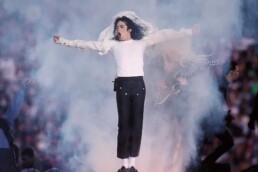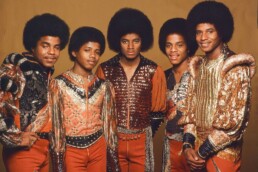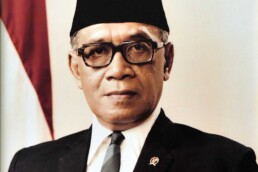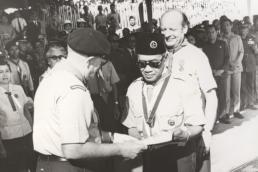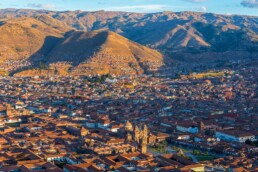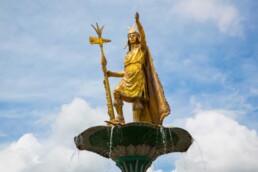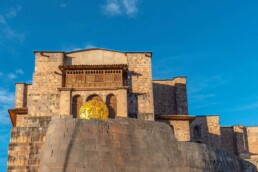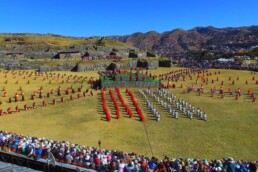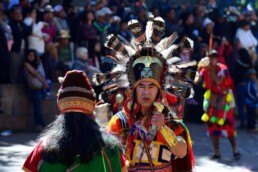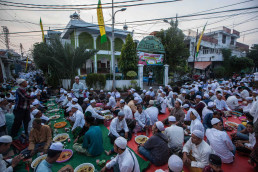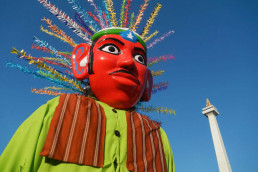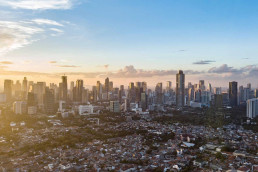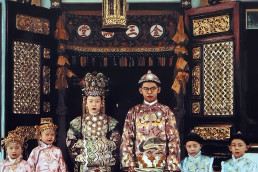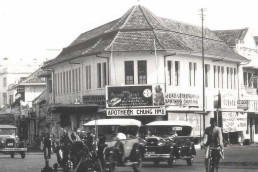Freddie Mercury: A Journey of Passion, Innovation, and Rock Majesty
Freddie Mercury, born Farrokh Bulsara on September 5, 1946, in Zanzibar, set out on a path that would take him from the bustling shores of East Africa to the peak of rock success. His early years were a complex mix of cultural influences, influenced by his Indian origin and British upbringing. Mercury’s formative years were defined by a deep affinity to music, since he was raised in the colourful traditions of his home Zanzibar before moving to England. This phase was critical in honing his skills and creating a passion that would eventually fascinate audiences all over the world.
Queen formed at the start of the 1970s, a band that would go on to reshape the landscape of rock music forever. Mercury, combined with the strong abilities of Brian May, Roger Taylor, and John Deacon, formed a creative and energetic group. Their partnership signalled the start of a revolutionary era in rock, distinguished by an unprecedented fusion of musical influences and theatrical flair. Queen’s distinct musical style, characterised by an eclectic blend of genres and a predilection for dramatic performances, established a new industry standard and caught the imagination of fans all over the world.
Mercury’s career was defined by his exceptional singing skills. His voice, known for its incredible range and emotional depth, became the foundation of his performances. With a vocal range of four octaves, he could transmit great emotion and strength in every note, distinguishing him from his contemporaries. His live performances were a display of fire and charisma, making each concert a unique experience. This powerful stage presence, combined with his distinct vocal powers, not only elevated Queen’s live shows but also reimagined the possibilities of rock performance.
Queen’s discography reflects their inventive attitude. The publication of “Bohemian Rhapsody” in 1975 was a watershed moment in music history, demonstrating the band’s ability to combine operatic elements with rock in a completely new way. This revolutionary music, with its complicated structure and genre-defying composition, attracted both audiences and critics. Anthems like “We Are the Champions” and “Somebody to Love” demonstrated their ability to combine many musical styles into cohesive, influential pieces. The band’s eagerness to experiment and push musical limits influenced the evolution of rock music.
Mercury’s influence went well beyond his musical triumphs. His candour about his personal life and position in the larger cultural environment was noteworthy in an era when such subjects were rarely discussed publicly. His presence and demeanour contributed to a larger conversation about identity and acceptance, pushing societal standards and opening the path for increased visibility and understanding in the entertainment business. This advocacy, combined with his great talent, highlighted his status as a forerunner in both music and cultural discourse.
Freddie Mercury’s legacy lingers long after his death in 1991. His music continues to captivate listeners of all ages, demonstrating the everlasting nature of his genius. The global success of the 2018 biopic “Bohemian Rhapsody” rekindled interest in his life and career, bringing his tale to a new generation and reinforcing his influence in the music industry. The continuous popularity of Queen’s songs, as well as the numerous tributes to his memory, demonstrate his career’s long-lasting effect.
Freddie Mercury’s impact on modern music and culture is still felt strongly today. His original approach to rock, stunning concerts, and distinctive personal story have left an indelible impression on the world. As his music continues to inspire and entertain, Mercury’s legacy exemplifies the enduring power of creativity and the enormous impact of a true creative visionary. Through his efforts, he has solidified his status as one of the most famous individuals in rock music history, and his tale continues to captivate and inspire fans across the world.
Michael Jackson: The King of Pop Moonwalked Through History
In the broad span of musical history, Michael Jackson stands out as a beacon whose radiance has lit and changed the globe. Jackson was born on August 29, 1958, in Gary, Indiana, and his amazing path from child star to global legend is a story of unparalleled talent and deep effect. As we mark his birth, we must look into his revolutionary influence, which reshaped not only the music industry but the entire cultural landscape.
Jackson’s brilliance was clear from the beginning of his time with the Jackson 5. His youth was a mosaic of intense rehearsal and public performances, showing a combination of familial ambition and natural brilliance. By the age of eleven, he had already begun to make his own way in the music industry, but it was his solo career that would fundamentally alter the nature of popular music and its global reach.
The release of “Thriller” in the 1980s was a watershed point in music history. This pioneering album was more than a compilation of songs; it was a cultural phenomenon that broke down traditional barriers. Jackson’s breakthrough music videos, particularly the cinematic masterpiece for the title track, not only redefined visual storytelling in music, but also created a universal language of rhythm and movement. “Thriller” became an epoch-defining work that demonstrated Jackson’s unrivalled ability to combine invention and artistry, leaving an enduring influence on worldwide pop culture.
Jackson’s influence grew far beyond the realm of music. His composition “Billie Jean,” with its classic bass line and mesmerising choreography, elevated music videos to the status of art. The moonwalk, a dancing motion that became iconic with Jackson, exemplified his amazing ability to combine performance with cultural effect. His visual and aural inventions transformed how we experience and hear music, inspiring many artists and setting new standards for creativity.
Furthermore, Jackson’s impact was global, influencing not simply Western pop culture but also resonating in a variety of cultural contexts. His philanthropic efforts, such as his support for humanitarian causes and involvement in “We Are the World,” demonstrated his dedication to global challenges and social change. Through these activities, Jackson expanded his reach beyond entertainment, exhibiting a deep concern for the world and its difficulties.
Despite his accomplishments, Jackson’s life was not free of scandal. Legal disputes and public scrutiny hampered his final years, frequently overshadowing his artistic achievements. These debates, while extremely complex, are part of a larger story that highlights the intense and sometimes intrusive nature of fame. They also illustrate the difficulties that people, such as Jackson, confront when balancing extraordinary talent with public scrutiny.
Exploring Jackson’s legacy reveals that his impact was extensive and diverse. His innovations in music and performance set new industry standards and influenced generations of musicians. His ability to engage people and cross cultural borders demonstrates a distinct artistic genius that transformed the worldwide entertainment landscape.
When we consider Jackson’s life and effect, it is clear that his legacy is a tapestry fashioned from threads of remarkable talent, tremendous impact, and complex personal experiences. His work continues to inspire and challenge us, sparking continuing discussions about the nature of fame and how we honour people who leave an indelible impression on our world.
Michael Jackson’s legacy exemplifies the ability of creativity to transcend boundaries and inspire. On his birthday, we commemorate not only his revolutionary contributions to music and culture, but also the ongoing questions his life and legacy raise. His accomplishments, like a melody that lasts long beyond the final note, will reverberate throughout history, reminding us of the amazing capacity for human expression and impact.
The Visionary Sultan's Behind Pramuka
The rhythmic chanting of excited young voices rises in the middle of Indonesia, bearing with them the adventure and friendship. These voices come together on August 14th to honour the ongoing heritage of Indonesian scouting on Pramuka Day. Derived from “Praja Muda Karana,” which means “young people willing to work,” Pramuka represents resiliency, patriotism, and the search for knowledge. To really appreciate Pramuka, though, we must return to the idea of its founding father, Sri Sultan Hamengkubuwono IX.
Born Raden Mas Dorodjatun, Sri Sultan Hamengkubuwono IX was not only a revered person in Indonesian history but also the visionary who planted Pramuka. Born in the Yogyakarta Sultanate in 1912, he received his education in the Netherlands, where he came across the worldwide scouting movement. Inspired by the ideas of Baden-Powell, the creator of the worldwide Scout organisation, Hamengkubuwono IX imagined a comparable program that might inculcate among young people of Indonesia unity, discipline, and patriotism.
Pramuka started his trip in the stormy years preceding Indonesia’s independence. The archipelago was rife with colonial tensions and fervent liberation movement activity. Against this background, the concept of a scouting movement evolved as a tool for developing national identity and leadership. Deeply committed to the cause of Indonesian freedom, Hamengkubuwono IX considered Pramuka as a necessary instrument in fostering a unified national character.
Gerakan Pramuka Indonesia was founded in 1961 by the official recognition of the scouting movement by the Indonesian authorities. Years of work and campaigning by Hamengkubuwono IX and other nationalists who saw the value of young organisation in national development came to pay off at the launch. The first ceremony took place at the Istana Negara, where President Sukarno formally presented the national flag to the young delegates, therefore initiating Pramuka.
The qualities of self-reliance, community service, and environmental preservation define Pramuka’s ideas rather thoroughly. The movement stresses learning by doing and pushes scouts to participate in a range of outdoor events promoting collaboration and useful skills. From community service initiatives to camping and hiking, these events are meant to help build character, resilience, and social responsibility.
The effect of Sri Sultan Hamengkubuwono IX on Pramuka transcends its early years. His life itself was evidence of the principles Pramuka advocates. He was instrumental in defending Yogyakarta’s cultural legacy from Japanese invaders throughout World War II. Later, serving as Indonesia’s vice president, he supported youth projects and education so that Pramuka’s values stayed fundamental for the country’s growth.
Pramuka has a major influence on Indonesian society. It has turned out generations of leaders carrying forward the flame of national pride and service. From busy metropolis to far-off villages, the movement now comprises millions of people across the island, drawn by the shared objective of improving Indonesia. Reflecting the scout motto of “Be Prepared,” Pramuka has also been very important in disaster relief and community building.
Pramuka Day reminds us annually of the movement Sri Sultan Hamengkubuwono IX helped start and his ongoing legacy. This is a day when scouts all throughout the country restiter their dedication to the scouting values and the vision of a united, self-reliant Indonesia. Reflecting the attitude of unity and group work, the celebrations are observed with rituals, parades, and community service events.
Pramuka’s values are still as important today as they were years ago as the world is fast changing. Staying faithful to its basic ideas, the movement keeps changing to fit the demands of contemporary society. It gives young Indonesians a stage on which to grow leaders, strengthen their feeling of community, and help their country to flourish.
In honour of not just the historical path of the scouting movement in Indonesia but also the everlasting vision of its founding father, Sri Sultan Hamengkubuwono IX, as we celebrate Pramuka Day Millions of scouts who want to live by ethics, service, and patriotism carry his legacy with them. Through Pramuka, the youthful energy of Indonesia keeps shining brilliantly, guiding us towards a time of harmony and prosperity.
The Doomsday Clock Reveals About Our Future
Moments of great importance in the annals of human history are sometimes distinguished by symbols that capture the spirit of their times. The Doomsday Clock is one such emblematic tool meant to mirror the imagined threat of world disaster. Designed by the Bulletin of the Atomic Scientists in 1947, the Clock has evolved into a vital gauge of human susceptibility to existential hazards ranging from nuclear conflict to climate change.
The devastation caused by World War II and the later arrival of nuclear weapons helped shape the Doomsday Clock. Comprising academics and scientists from the Manhattan Project, the Bulletin of the Atomic Scientists aimed to convey the dangerous situation of world events as the Cold War started. The Clock was thus born as a symbolic tool, its hands creeping towards midnight to indicate a growing likelihood of world catastrophe.
Originally scheduled for seven minutes to midnight, the Clock’s placement has been changed several times in response to the shifting terrain of environmental concerns and world affairs. Every change captures the collective assessment of the most urgent threats facing the planet. During times of increased suspense, like the Cuban Missile Crisis, the hands have ticked closer to midnight; they have also retreated during times of relative calm.
The symbolism of the Clock transcends nuclear dangers. It has also included additional worldwide hazards in recent years: climate change, biological hazards, and new technology. This more general approach recognises that existential dangers affect a variety of elements endangering the destiny of the earth rather than limited to the domain of nuclear war.
The Clock’s changes mirror a growing worry about climate change. The Bulletin has often moved the hands towards midnight as scientific evidence of global warming mounts, underlining the need of tackling environmental damage. Rising sea levels, severe storms, and loss of biodiversity—all of which are effects of climate change—cause great hazards to world stability and human well-being. The Clock reminds us strongly of the need of group effort to reduce these hazards.
Including other worldwide hazards into the Clock’s equation shows how linked modern hazards are. Emerging technologies bring fresh questions especially in the fields of artificial intelligence and biotechnology. The possibility for abuse or unanticipated results of these developments complicates the scene of world risk. The changes made by the Clock reflect these changing issues and underline the need of proactive measures in many spheres since protecting the future calls for awareness.
Beyond its symbolic depiction, the Doomsday Clock has influence. It draws attention to important concerns and motivates public and governmental reactions, therefore acting as a catalyst for communication and action. The Clock has become a potent weapon for increasing awareness and pushing for change by converting abstract dangers into a concrete metric. Its appearance in media and scholarly debates emphasises the need of ongoing efforts to solve world problems and support environmentally friendly solutions.
The Doomsday Clock is not without controversy even if its great importance is undeniable. Some contend that its symbolism either oversimplifies difficult problems or encourages a fatalism. Others argue that its vivid depiction of risk could eclipse small but significant advancements towards the resolution of world concerns. Still, the Clock is a moving emblem of the need of group accountability and planning.
The Doomsday Clock is both a warning and a call to action as we negotiate a time marked by fast technology development, geopolitical changes, and environmental difficulties. Its ongoing significance emphasises how urgently world cooperation and creative ideas are needed to solve the several challenges confronting humans. The motions of the Clock provide a sombre commentary on the situation of our planet and a reminder of our collective need to protect a better, more sustainable future.
The Doomsday Clock captures essentially a great truth: our capacity to face and reduce existential hazards determines the course of human civilisation. Its hands, always poised to approach or distance from midnight, reflect the unstable equilibrium between risk and advancement. The Clock is still an essential tool for assessing our combined efforts and our will to protect the planet for next generations as we enter an unknown future.
Celebrating MTV’s Revolutionary Journey To Changed The World
The early 1980s were a period of cultural and technological upheaval. As cable television became more prevalent in American households, people’s media consumption habits changed dramatically. In the middle of this transition, a groundbreaking endeavour was about to forever alter the landscape of popular culture. On August 1, 1981, MTV (Music Television) made its debut, ushering in a new era of music and entertainment. The Buggles’ “Video Killed the Radio Star” was a symbolic and literal statement of the dramatic transformation that MTV would bring.
MTV’s concept was audaciously basic but profoundly innovative: a 24-hour channel dedicated solely to music videos. This original notion drew audiences, particularly young people who were looking for a new and exciting way to interact with their favourite musicians. The channel’s introduction of Video Jockeys (VJs) as dynamic hosts provided a personal touch to the viewing experience, making it more participatory and enjoyable. MTV swiftly became a cultural phenomenon, more than just a music channel, with a strong influence on fashion, language, and lifestyle.
It’s impact on the music industry was instantaneous and dramatic. For musicians, having their music videos shown on MTV might propel them to fame. The visual component of music videos provided a new dimension to artistry, allowing performers to express themselves beyond auditory records. Iconic videos like Michael Jackson’s “Thriller,” with its innovative production and dancing, and Madonna’s “Like a Virgin,” with its daring images, became cultural icons. These videos did more than merely sell songs; they built visual narratives that got deeply embedded in the popular mind.
Beyond individual artists, MTV had a tremendous impact on the music industry’s economy. Music videos became indispensable marketing tools, propelling album sales and concert attendance. The symbiotic relationship between MTV and the music industry created an environment in which visual artistry was valued as much as musical genius, ushering in a golden age of music videos.
MTV’s effect stretched well beyond music. The channel became a cultural reference point, reflecting and driving societal trends. The fashion choices of MTV performers, from Madonna’s edgy style to the glam rock appearance of bands like Duran Duran, served as inspiration for youth fashion. MTV did more than just transmit music; it also aired a lifestyle that millions of people aspired to. Shows like “MTV Unplugged,” which highlighted musicians’ acoustic performances, and “Yo! MTV Raps,” which introduced hip-hop to a larger audience, helped to widen the channel’s cultural influence.
Recognising the potential of its platform, the channel began to address social and political concerns as well. Campaigns such as “Rock the Vote” encouraged young people to participate in the democratic process, and its coverage of major events provided a youthful viewpoint on news that was frequently omitted from mainstream media. This willingness to address crucial issues contributed to MTV’s reputation as more than just an entertainment channel; it became a voice for a generation.
However, the technological developments that once empowered MTV later presented serious obstacles. The development of the internet in the late 1990s and early 2000s transformed how people consumed music and information. The introduction of platforms like as YouTube provided fast access to a wide range of music videos, reducing the requirement for a dedicated music video channel. Streaming services further split viewing by offering personalised music experiences that MTV couldn’t imitate.
In response, MTV tried to change its focus from music videos to reality television and other non-music programs. Shows like “The Real World,” “Jersey Shore,” and “Teen Mom” attracted large audiences and kept the channel relevant for a while. However, this shift sparked accusations that MTV had drifted too far from its original objective, alienating core viewers who had grown up with its music-focused reputation.
Despite these efforts, MTV’s cultural influence was clearly declining. The channel that was once at the vanguard of musical and cultural innovation struggled to stay relevant in a swiftly changing digital market. While MTV still exists, its influence has been significantly weakened, overshadowed by the very technology developments it once championed.
Reflecting on the beginning of MTV, it is apparent that it had a significant and far-reaching impact. It transformed the music industry, altered global culture, and provided a voice for a generation. Though it eventually succumbed to the very forces of change that it helped to initiate, MTV’s impact as a cultural pioneer is undeniable. The narrative of MTV demonstrates the power of invention and the ever-changing nature of media and entertainment.
One Giant Leap: The Mission and Humanity’s Triumph on the Moon
In the annals of human history, the Apollo 11 mission represents a tremendous testament to human inventiveness and tenacity. Apollo 11 was launched on July 16, 1969, from the Kennedy Space Centre in Florida, marking the culmination of a decade-long race that gripped the world’s imagination. This astonishing journey to the Moon was more than just a scientific accomplishment; it also represented geopolitical competition and human aspiration.
The Apollo 11 mission originated during the Cold War, a period of strong political and ideological confrontation between the United States and the Soviet Union. The space race was an outgrowth of this rivalry, with both nations competing for supremacy beyond Earth’s atmosphere. The stakes were great, not only for national prestige, but also for technological leadership and scientific progress.
The Soviet Union had made major advances in space research, including the launch of the first artificial satellite, Sputnik, in 1957 and the first human in space, Yuri Gagarin, in 1961. These feats paved the way for unprecedented competition, prompting the United States to boost its own space programme. On May 25, 1961, President John F. Kennedy delivered his famous speech to a joint session of Congress, which galvanised American resolve. In a moment of tremendous clarity and vision, Kennedy announced the lofty objective of landing a man on the Moon and safely returning him to Earth by the end of the decade. His remarks, “We choose to go to the Moon in this decade and do the other things, not because they are easy, but because they are hard,” were a rallying cry that energised a nation and laid the groundwork for what would become one of humanity’s greatest achievements.
Kennedy’s address was more than just rhetoric; it was a statement of intent that would motivate NASA and its employees. The Apollo programme, which began in response to Kennedy’s challenge, was a gigantic operation involving thousands of scientists, engineers, and technicians. Only the ambition that drove the programme could match its intricacy and magnitude. The Apollo 11 mission, launched in July 1969, was the pinnacle of this united endeavour.
The spacecraft, which included the Command Module “Columbia” and the Lunar Module “Eagle,” was launched using the Saturn V rocket, the most powerful rocket ever built. After travelling roughly 384,400 km, the lunar module separated from the command module and began its descent to the Moon’s surface. When “Eagle” landed in the Sea of Tranquilly on July 20, 1969, Neil Armstrong, the mission commander, became the first human to set foot on another celestial body. His famous remarks, “That’s one small step for [a] man, one giant leap for mankind,” reverberated far beyond the lunar surface, representing the unity and potential of human endeavour.
The Moonwalk was more than just an engineering accomplishment; it was also a powerful moment of human connection. For millions of people throughout the world, it symbolised the realisation of a goal that seemed nearly unbelievable just a decade before. Armstrong and Buzz Aldrin’s brief but historic visit to the lunar surface was aired live, thrilling audiences and instilling a sense of shared accomplishment. Michael Collins, the command module pilot, orbited the Moon alone, guaranteeing the crew’ safe return.
Apollo 11’s triumph was more than just a victory for the United States; it was a global milestone that crossed national lines. The project highlighted the tremendous powers of human inventiveness and international teamwork, paving the way for future space exploration. It also emphasised the necessity of vision and leadership in accomplishing seemingly impossible tasks. The lessons learnt from Apollo 11 continue to affect space exploration and technological innovation today.
In retrospect, the Apollo 11 mission remains a strong symbol of human ambition and accomplishment. It was a watershed event in history, demonstrating how adversity, ambition, and partnership can propel humanity towards incredible achievements. Apollo 11’s legacy lives on not only in space travel, but also in the collective spirit of discovery and adventure, which continues to inspire future generations. As we reflect on this great feat, it serves as a reminder of what humanity is capable of when motivated by a common vision and an unrelenting commitment to exploring the unknown.
The Legendary Sea Captain Who Defied the Spanish Armada
Sir Francis Drake’s narrative is one of adventure, controversy, and long-term consequence. Drake was born in Tavistock, Devon, approximately 1540, and rose from humble beginnings to become one of history’s most famous sea captains. His adventures on the high seas have had a lasting impact on the world, inspiring exploration, maritime combat, and worldwide trade.
Drake grew up by the water, immersed in England’s nautical culture. His career began with the tutelage of his cousin, Sir John Hawkins, a well-known privateer. During these formative years, he took part in journeys to the Americas and the booming slave traffic, which polished his navigational abilities and adventurous spirit.
His most recognised achievement was his circuit of the globe between 1577 and 1580. This remarkable voyage was only the second successful circumnavigation since Magellan’s expedition. The expedition was laden with danger, from dangerous seas to unfriendly encounters, but it cemented his reputation as an adventurous explorer. This feat demonstrated not only the potential of global sea travel, but also the strategic and economic advantages of such endeavours.
The voyage had far-reaching ramifications for England and the world. It established the viability of long-distance sea expeditions, laying the groundwork for future explorations and the eventual construction of global commerce networks. This expedition also gave vital geographical knowledge, which aided the world’s comprehension of hitherto unknown places. The successful sailing of the Strait of Magellan and the discovery of new Pacific routes were especially important, influencing future nautical exploration.
Drake’s escapades were not restricted to exploration. In 1587, he led a daring raid on the Spanish port of Cadiz, which became known as the “singeing of the King of Spain’s beard.” This daring strike disrupted the Spanish Armada’s invasion plans and demonstrated Drake’s tactical prowess. His leadership during the defeat of the Spanish Armada in 1588 solidified his reputation as a national hero. The strategic deployment of fire ships and creative naval tactics were critical in repelling the Spanish armada, defending England from invasion, and shifting the balance of power in Europe.
The defeat of Spain’s Armada had far-reaching ramifications. It signalled the end of Spain’s naval dominance and the development of England as a powerful maritime power. This move had far-reaching economic and political repercussions, allowing the English to expand their dominance and establish colonies in the New World. Drake’s role in this critical event demonstrated the strategic value of naval might, as well as the potential for marine exploration and warfare.
Despite his valiant efforts, Drake’s legacy is not without dispute. His role in the slave trade casts a pall over his accomplishments, emphasising the negative sides of his career. The ethical ramifications of his actions continue to spark debate, highlighting the intricacies of historical personalities and the diverse character of their legacies.
His influence on English culture is clear from the countless references to his exploits in literature, art, and folklore. Queen Elizabeth I bestowed knighthood upon him in 1581, symbolising his achievements to the nation and role in strengthening English authority. His exploits sparked numerous legends and became etched in the national psyche, moulding public perceptions of exploration and valour.
Significant places related to Drake’s life and voyages, such as his birthplace in Tavistock and his residence in Plymouth, provide a concrete link to his legacy. Drake’s Island in Plymouth Sound and Drake’s Bay in California serve as reminders of his global influence. These locations draw history buffs and tourists, offering glimpses into the life and times of this great character.
Drake’s journeys influenced subsequent generations of explorers and adventurers, from the Elizabethan era to the Age of Discovery and beyond. His contributions to navigation and marine exploration expanded the subject tremendously, instilling a sense of curiosity and ambition that drove humanity to explore the world’s outer reaches.
In summarising his legacy, it is apparent that his most major contributions were to global exploration and maritime dominance. His tour of the globe and key role in defeating the Spanish Armada changed the geopolitical landscape, paving the door for global commercial expansion and the formation of English colonies. These accomplishments demonstrate the transforming potential of exploration and the long-lasting impact of a single individual on the course of history.
The legacy exemplifies the eternal spirit of adventure and the pursuit of knowledge that defines the human condition. Exploring the historical landmarks related with his life and diving deeper into his intriguing narrative allows us to better understand the complexity and accomplishments of a man who transformed the world. For those interested in history, culture, and travel, Sir Francis Drake’s life is a fascinating voyage through the ages, illustrating the deep impact of exploration on our worldwide heritage.
The Living Heritage of Cusco’s Inca Roots
Cusco often known as the “Navel of the World,” is a city where the past and present blend effortlessly, creating Inca legacy that continues to form its character. Cusco, nestled in the Andes highlands, was once the capital of the great Inca Empire, a civilization known for its architectural skill, agricultural advances, and intricate social institutions. Today, the city’s rich history and long-standing cultural customs make it an intriguing destination for both tourists and historians.
The city has a rich history and legends surrounding its origins. According to Inca mythology, Manco Cápac and Mama Ocllo established the city after emerging from Lake Titicaca at the order of the sun deity Inti. Archaeological evidence, however, indicates that Cusco was already a large settlement before the Incas ascended to power in the early thirteenth century. Cusco, led by Inca monarch Pachacuti, was built into a huge metropolitan centre that reflected the empire’s majesty and refinement.
Inca architecture shows the ancient civilization’s great technical and creative skills. The city’s layout was precisely constructed to coincide with celestial phenomena, demonstrating the Incas’ strong connection to their surroundings. Cusco was constructed in the shape of a puma, a sacred animal in Inca mythology that represents strength and wisdom. The puma’s head was represented by Sacsayhuamán, a fearsome stronghold above the city, while its body sprawled out across the urban landscape. This layout not only had symbolic value, but it also demonstrated the Incas’ ability to combine urban planning with their spiritual beliefs.
One of the most notable aspects of Inca architecture is its precise masonry. Massive stones were carved and fitted together with such precision that no blade of grass could fit between them, as seen in Sacsayhuamán’s walls and the Qorikancha temple. The trapezoidal doors and windows, which were built to withstand earthquakes, demonstrate the Incas’ architectural inventiveness. The streets were set out in a grid arrangement, which facilitated efficient mobility and improved the city’s defensive capabilities. Canals and aqueducts crisscrossed the city, providing a consistent water supply and demonstrating the Incas’ advanced mastery of hydraulics.
Cusco was more than just an architectural marvel; it was also the Inca Empire’s spiritual centre. The Qorikancha, or Temple of the Sun, was the most sacred location, dedicated to Inti, the sun god. It was covered in gold, symbolising the Incas’ wealth and adoration for their deities. Today, the vestiges of Qorikancha are juxtaposed with the Spanish colonial church of Santo Domingo, forming a moving visual tale of invasion and cultural blending.
Religious traditions in were firmly interwoven in the Incas’ everyday existence. Major festivals, such as Inti Raymi, the Festival of the Sun, were marked by elaborate rites and rituals. This winter solstice festival honoured the sun god while also ensuring the land’s fertility. Even today, Inti Raymi is reenacted with tremendous enthusiasm, attracting both residents and tourists to see this vivid show. The ongoing commemoration of such festivities demonstrates the Inca customs’ persistent influence in modern Cusco.
The social structure of Inca civilization was complex and hierarchical. The Sapa Inca, seen as a divine sovereign, reigned supreme. Below him were the nobles, who oversaw the empire’s vast lands, and the commoners, who cultivated the land and served in a variety of roles. This hierarchical structure was reflected in the city’s layout, with separate zones designated for different classes and functions. The agricultural terraces surrounding Cusco, such as those in the Sacred Valley, demonstrate the Incas’ creative farming practices and ability to adapt to the harsh Andean climate.
The entrance of Spanish conquistadors in the 16th century constituted a watershed moment in Cusco’s history. During the conquest, numerous Inca structures were destroyed and either disassembled or converted for colonial use. Despite this, the indomitable spirit of the Inca tradition endured. The blend of Inca and Spanish influences is obvious in Cusco’s architecture, where colonial churches rest on ancient foundations, as well as the city’s cultural activities, which combine indigenous and European components.
In modern-day Cusco, there are initiatives to conserve and honour the Inca history. The city has been classified as a UNESCO World Heritage Site, recognising its historical significance and the need for preservation. Initiatives to restore and maintain Inca monuments, as well as promote traditional festivals and crafts, are critical to preserving the cultural legacy. Tourism has provided economic benefits, but it also presents obstacles, such as the need to balance development with preservation.
The city provides visitors with numerous opportunity to learn about the city’s rich Inca past. Sacsayhuamán, Qorikancha, and the Sacred Valley offer insights into the Incas’ architectural and cultural achievements. Participating in local festivities like Inti Raymi and visiting crowded markets selling traditional crafts provide immersive cultural experiences. These connections not only enrich the vacation experience, but also contribute to the preservation of Cusco’s distinct cultural identity.
Cusco is a lively reminder of the Inca civilization’s ongoing influence. Its streets and structures tell stories of a magnificent empire, and its cultural rituals preserve the Inca spirit. The city’s capacity to honour its history while embracing the present transforms it into a living museum and bustling cultural centre. Exploring Cusco is more than just a voyage through time; it’s an invitation to witness the tenacity and continuity of an exceptional history that continues to inspire and captivate the world.
Jakarta: Embracing Its Past, Celebrating Its Future
On this momentous occasion, we celebrate the birthday of Jakarta, a city that has long stood as the vibrant heart of Indonesia. Known for its bustling streets, towering skyscrapers, and rich of cultures, Jakarta has been a melting pot of traditions, languages, and lifestyles. As we honor Jakarta’s legacy, we also look to its future, especially with the impending relocation of Indonesia’s capital to Borneo. This transition marks a significant chapter in Jakarta’s story, filled with both challenges and opportunities.
Jakarta’s history as a cultural melting pot dates back centuries, to when it was a thriving port city known as Sunda Kelapa. In the 16th century, the Portuguese, followed by the Dutch, recognized its strategic importance, leading to centuries of colonial rule under the name Batavia. This period saw an influx of diverse populations, including Chinese traders, Arab merchants, and Indian laborers, each leaving an indelible mark on the city’s cultural fabric.
After gaining independence in 1945, Jakarta was rechristened and transformed into the capital of Indonesia. The city’s evolution continued as it welcomed migrants from all corners of the archipelago, each bringing their unique customs, cuisines, and traditions. Today, Jakarta is a microcosm of Indonesia, where Javanese, Sundanese, Batak, Minangkabau, and countless other ethnic groups coexist.
Jakarta’s diversity is reflected in its neighbourhoods, each with its distinct character. In Glodok, Jakarta’s Chinatown, the air is filled with the aroma of traditional Chinese dishes, and temples like Vihara Dharma Bhakti stand as testaments to the community’s deep roots. Similarly, the area of Kampung Arab in Tanah Abang showcases Arab culture with its Middle Eastern eateries, mosques, and vibrant markets.
The Betawi people, native to Jakarta, also play a significant role in the city’s cultural landscape. Their traditional music, dances like the colourful Ondel-Ondel, and culinary delights such as Kerak Telor and Soto Betawi, provide a unique local flavour that is quintessentially Jakartan.
Festivals in Jakarta further illustrate this rich cultural mosaic. The Chinese New Year, Idul Fitri, Christmas, and Hindu festivals are celebrated with equal fervour, each adding to the city’s festive calendar. Events like the Jakarta Fair and cultural parades highlight the city’s commitment to honouring its diverse heritage.
However, Jakarta’s rapid growth has not come without challenges. The city faces significant issues, including traffic congestion, flooding, and pollution. Its infrastructure is often strained by the demands of its more than 10 million residents. In response to these challenges, the Indonesian government has embarked on ambitious projects to modernise the city. The Mass Rapid Transit (MRT) system, improved flood control measures, and green spaces like the revitalised Kalijodo Park are steps towards creating a more sustainable urban environment.
One of the most transformative changes on the horizon for Jakarta is the relocation of Indonesia’s capital to Nusantara in East Kalimantan, Borneo. This decision, announced by President Joko Widodo, aims to reduce the burden on Jakarta and promote more balanced economic development across the country. The new capital is envisioned as a smart, green city, designed to address issues of sustainability and resilience to climate change.
While the move signifies a new chapter for Indonesia, it also presents an opportunity for Jakarta to redefine itself. Freed from the administrative pressures of being the capital, Jakarta can focus on becoming a global city, enhancing its role as the economic and cultural hub of Southeast Asia. Investments in technology, infrastructure, and tourism can help Jakarta leverage its rich cultural heritage while embracing modernity.
As we celebrate Jakarta’s birthday, it is essential to acknowledge both its historical significance and its dynamic future. Jakarta’s story is one of resilience and transformation, a city that has continuously evolved while remaining true to its multicultural roots. The impending relocation of the capital does not diminish Jakarta’s importance; rather, it offers a chance for reinvention and growth.
In this period of transition, the spirit of Jakarta remains vibrant. Its bustling markets, diverse culinary scene, and the harmonious coexistence of different cultures are a testament to its enduring legacy. As the city looks forward to a new era, it carries with it the lessons of the past and the promise of a bright, inclusive future.
Happy Birthday, Jakarta. Here’s to celebrating your past, embracing your present, and looking forward to your future.
Spice Up Your Bahasa with Some Secret Hokkien Flavors
Indonesia, a vibrant archipelago comprising thousands of islands, is both culturally and linguistically diverse. This complicated blend is represented by the national language, Bahasa Indonesia, which incorporates elements of Arabic, Sanskrit, and European languages. However, a lesser-known but significant contributor lies beneath the surface: Hokkien, a Chinese dialect.
Hokkien is a Southern Min dialect that originated in Fujian province, China. Historically, Chinese traders, many of whom spoke Hokkien, travelled extensively throughout Southeast Asia, bringing not only unusual goods but also some of their original language. These encounters persisted for decades, leaving an enduring imprint on the languages and civilizations they encountered. In Indonesia, Hokkien’s impact may still be heard in everyday conversations, showing a long history of cultural interchange.
The relationship between Hokkien and Bahasa Indonesia dates back millennia. Around the fifteenth century, Chinese traders built commercial contacts with Southeast Asia, with many settling in Indonesia’s thriving port cities like Jakarta and Semarang. These traders established Peranakan villages, which grew and blended with the local population. Hokkien, a business and daily language, organically melded with native speech, resulting in a distinct linguistic hybrid.
During the Dutch colonial period, Hokkien’s influence grew stronger as the Dutch hired Chinese labourers. This integration enabled a lively exchange of language and culture. Words with Hokkien roots such as “pisau” (knife), “teh” (tea), and “mie” (noodles) have become staples of Indonesian language and cuisine.
Many commonly used words in Bahasa Indonesia reflect Hokkien influence. Here are few examples:
Lu: Derived from Hokkien, “lo” signifies “you” in informal circumstances and is commonly used by friends.
Gua: Another Hokkien loanword, “gw” signifies “I” or “me,” reflecting personal pronouns used in ordinary speech.
Bakso: Meaning “meatballs,” this word is derived from the Hokkien “bak-so,” demonstrating the culinary influence on Indonesian cuisine.
Mie: Derived from the Hokkien word “mi,” which means “noodles,” this name is widely used in Indonesian food culture.
Teh: The word for “tea,” derived directly from Hokkien “te.”
Pisau: Meaning “knife,” derives from the Hokkien “pi-siu.”
Bihun: This phrase, which means “rice vermicelli,” is derived from the Hokkien “bi-hun.”
Becak: A sort of rickshaw derived from the Hokkien word “be-tsia.”
Lumpia: Spring rolls comes from the Hokkien word “lun-pia.”
Kue: Meaning “cake,” this phrase is derived from Hokkien “kueh.”
Kecap: The name meaning “soy sauce,” derived from the Hokkien “ke-tsiap.”
Loteng: “Attic,” comes from Hokkien “lu-teng.”
Koko: “Older brother,” derived from Hokkien “ko-ko.”
Cici: Meaning “older sister,” derived from the Hokkien “chi-chi.”
Kongsi: The term “partnership” or “company,” derives from the Hokkien “kong-si.”
Halo: A frequent greeting, akin to “hello,” that demonstrates Hokkien influence in informal salutations.
These terms indicate how thoroughly Hokkien has permeated common Indonesian speech, owing to past connections between Chinese traders and local groups.
The significance of Hokkien goes beyond words. Peranakan populations, particularly in Medan and West Kalimantan, have established a unique cultural identity that combines Chinese and Indonesian influences. This mix is reflected in their cuisine, architecture, and social norms. For example, Peranakan cuisine includes dishes like as “lumpia” (spring rolls) and “bihun” (rice vermicelli) that mix Chinese and Indonesian flavours.
Architecturally, Peranakan houses frequently include elaborate tilework and Chinese calligraphy, acting as cultural bridges between China and Indonesia. These dwellings are not only visually appealing, but they also serve as historical markers, highlighting the long-standing presence of Hokkien speakers in Indonesia.
Indonesia’s cultural landscape reflects its history as a melting pot of various influences. The archipelago has absorbed components from numerous cultures, including Chinese, Indian, Arabic, and European, resulting in a diverse and complex society. Language, cuisine, art, and architecture all represent this cultural mix.
The presence of Hokkien in Bahasa Indonesia demonstrates how languages evolve through cultural interaction. Unlike European influences brought about by colonisation, Hokkien’s presence expanded organically via trade and community interaction. This resulted in a remarkable absorption of vocabulary, with Hokkien words woven into the fabric of everyday Indonesian speech.
While the number of Hokkien loanwords has decreased in recent years, their existence remains a vibrant reminder of the past. As Indonesia evolves, these linguistic gems serve as cultural bridges, encouraging understanding and appreciation of the country’s many influences. Efforts to revitalise Hokkien among Indonesian Chinese communities are presently underway, ensuring that the whispers of this historic language continue to ring out for future generations.
So, the next time you eat a steaming bowl of “bakso” or greet a friend with “halo,” recall the Hokkien whispers embedded in these expressions. They highlight language’s enduring strength as a tool for cultural interaction, transmitting stories from the past while improving the present. The presence of Hokkien in Bahasa Indonesia serves as a reminder that languages, like cultures, are constantly evolving, leaving their imprint on the encounters and relationships that shape our world.



